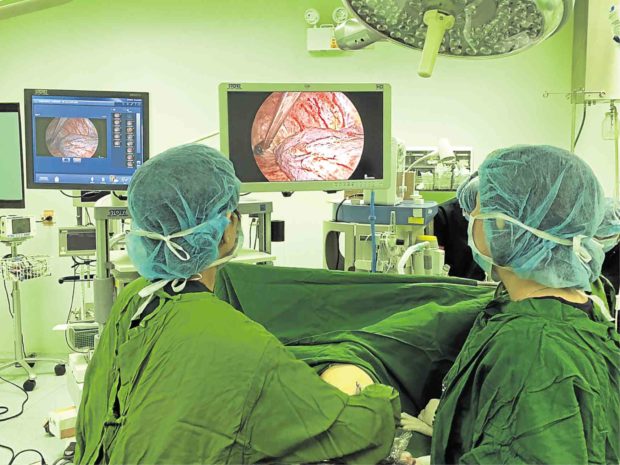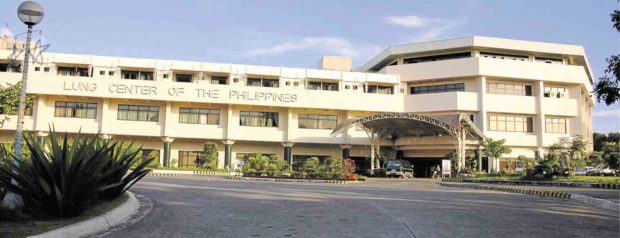Breathing new life into the Lung Center

MAGNIFIED 10 TIMES The single-port VATS machine offers a high-definition image 10 times its actual size, allowing surgeons to perform medical procedures a lot better and faster, and with less anesthesia exposure to patients. —CONTRIBUTED PHOTO
Filipinos suffering from pulmonary and other chest ailments can now heave a sigh of relief: from near bankruptcy, the government-owned and -controlled Lung Center of the Philippines (LCP) has become one of the best in Asia.
For the past four years, the LCP has been using modern facilities and performing state-of-the-art surgery to make life a lot easier for patients.
Opened in 1981, the LCP has come a long way from its insolvency in 2011, thanks to efficient management systems that discouraged corrupt practices and steered it to become a profitable hospital reportedly worth P1 billion these days.
Executive director Dr. Vincent Balanag credited his predecessor, Dr. Jose Luis Danguilan, for leading the LCP to its current status. “Dr. Danguilan’s thrust was to improve the facilities and make the hospital more competitive [like] its private counterparts,” Balanag said, adding that the LCP started acquiring new equipment through the efforts of then Health Secretary Enrique Ona.
On March 23 and 24, an international delegation of 12 top thoracic surgeons will gather at the LCP’s Enrique M. Garcia Auditorium for the 6th Asian Single Port VATS Symposium, proof of the hospital’s world-class status.
Article continues after this advertisementMinimally invasive surgery
Article continues after this advertisementSingle-port VATS (video-assisted thoracoscopic surgery) is a specialized, minimally invasive surgery method practiced worldwide in the treatment of different types of lung diseases.
The best thing about it is that instead of an 8- to 12-inch incision, doctors make only one 1.57-inch (4-centimeter) incision, which reduces postoperative pain among patients, said Dr. Danguilan of the LCP’s Department of Thoracic Surgery and Anesthesia.
Danguilan, head of the symposium’s scientific committee, added: “Using VATS also means a shorter hospital stay because it results in less blood loss that practically eliminates the need for blood transfusion.”
He revealed that “elderly patients aged 70 and above, who had been denied an open procedure, were operated on using VATS, and were discharged from the hospital two to three days after the procedure.”
The learning curve among the LCP doctors was not that steep either.
“The more senior thoracic surgeons, who were previously performing hundreds of open or traditional surgery inside the chest (thoracotomy), learned the VATS procedure by observing or training in short-course workshops in the Philippines and abroad,” Danguilan said.
Asian thoracic surgeons who adapted the procedure earlier were invited to demonstrate it at the LCP, he added.
“Credit should also be given to Drs. Guillermo Barroa Jr. and Camilo Pada, the chair and training officer of the LCP Department of Thoracic Surgery, respectively, because they encouraged the use of VATS among the surgical staff,” Danguilan said, adding that the surgeons took to the technology “like ducks take to water.”
Said Dr. Barroa Jr.: “The machines for minimally invasive surgery magnify the area being operated on 10 times its actual size, making the procedure safer.”
Dr. James Monje, LCP consultant anesthesiologist, noted that the high-definition imaging offered by the new machines allowed better performance of surgical procedures, “making surgery a lot faster and with less anesthesia exposure to patients.”
But the hospital, said Dr. Theresa M. Alcantara, LCP chief of the anesthesia division, “needs to invest more on this type of equipment to make it more affordable to Filipinos. It also needs to collaborate more with PhilHealth to allow more patients to avail themselves of minimally invasive surgery.”
First workshop in Asia
The LCP has actually been performing VATS since 1993, with the first workshop in Asia held at the hospital and conducted by American thoracic surgeons. But fire razed the LCP in 1998 and stalled the procedure’s extensive use.
In 2013, then Health Secretary Ona provided the funds to modernize four specialty hospitals—the Philippine Heart Center, National Kidney and Transplant Institute, Philippine Children’s Medical Center and the LCP, allowing the hospital to perform VATS on more patients—3,000 of them since 2014.
Danguilan said that “major VATS procedures, like lobectomies, or the removal of part of the lung mostly in end-stage pulmonary tuberculosis and lung cancer, had been done on 500 patients.”
This year, the LCP will be opening its esophagus center for the diagnosis and treatment of disorders of the esophagus, the tube connecting the oral cavity to the stomach.
One of its goals, Danguilan said, was “to introduce VATS for the removal of tumors of the esophagus, which is usually performed through two or three large incisions in the neck, chest and the abdomen.”
With this development, the LCP, the only tertiary or major government hospital for pulmonary and other chest diseases in the Philippines, will keep abreast with its Asian neighbors in cutting-edge services.
Breakthrough effort
“Young Filipino thoracic surgeons are undergoing further training and exposure in famous VATS centers of excellence in Hong Kong, Japan, Singapore and Taiwan,” Danguilan said. “Efforts are underway to provide further training in China through the efforts of another LCP thoracic surgeon, Dr. Antonio Ramos.”
Gathering Asia’s and Europe’s best in Manila for the VATS symposium is a breakthrough effort, according to organizers Drs. Federico Sanchez, Rey Desales and Ramos, the leaders of the Philippine Association of Minimally Invasive Thoracic Surgeons.
Among other facilities, the LCP is the only hospital in the country to have two linear accelerators, which deliver high-energy X-rays or electrons to destroy cancer cells in the tumor while sparing surrounding normal tissue, Danguilan said.
The hospital is set to acquire other medical equipment this year not only for lung disease, but also for its sleep laboratory and stem cell lab.
Also in the works is a multidisciplinary pain management clinic being established by Dr. Alcantara for lung cancer patients in their terminal stage.
Lung cancer and tuberculosis are among the top 10 deadliest ailments in the Philippines. In fact, lung disease is the top cause of cancer-related deaths among Filipino males and the third highest cause of cancer-related deaths in females, according to the Philippine Council For Health Research and Development.
